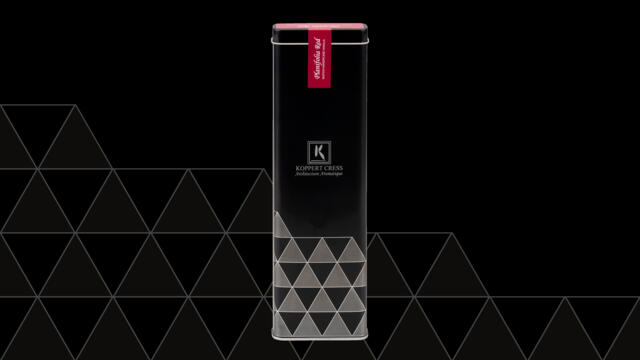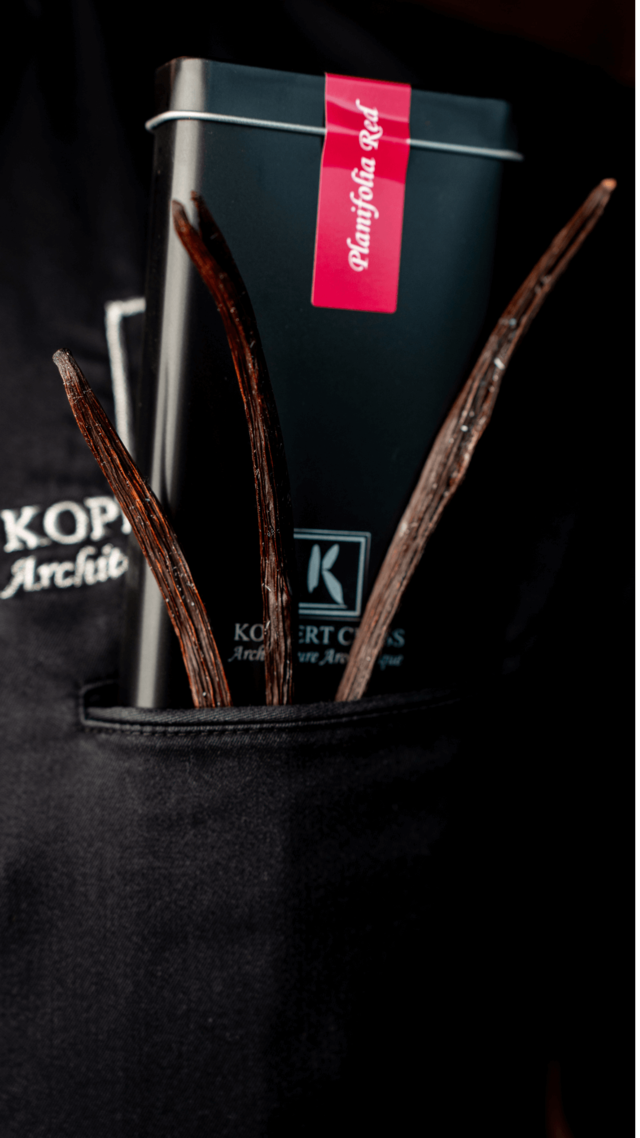
The return of 'vine riped' vanilla, Dutch 'Vine riped' vanilla (ripened on the plant) as nature intended
Category: World of Plants
Because the pod is connected to the plant for longer, it acquires an even nicer flavour profile, which from a culinary point of view offers countless new possibilities with specific notes of flowers, freshness, red fruit and butterscotch.
Quality of Planifolia Red
Koppert Cress takes pride in their Planifolia Red, a pinnacle of their precise growing and curing methods. With a Vanillin content of at least 3% at an indexed moisture level of 26%, this vanilla embodies excellence from cultivation to presentation.
The frosted allure of their Planifolia Red is more than a surface adornment—it's a promise of unparalleled taste and sensory delight. From vine to bean, dedication to perfection yields a vanilla of unparalleled complexity, destined to elevate culinary creations with its rich and nuanced flavor profile. This visual cue heralds not just quality but a depth of flavor unrivaled by its counterparts.
Growing
At Koppert Cress we grow vanilla in a controlled environment which allows to have full control over quality from start to finish. In the meticulous art of cultivating vanilla, every step from growth to presentation is crucial for achieving the finest quality. It begins with the careful nurturing of the Vanilla Planifolia variety, renowned for its exquisite flavor profile. Classically, Vanilla is grown in tropical areas where it is prone to extreme weather conditions, crime and corruption. By growing in a controlled environment, the flowers are protected from the wind, ensuring the pollen is well-protected and minimizing loss. At Koppert Cress, we don't pollinate all flowers; assessing the rigor of the vine, managing the number of pods accordingly. Over-pollination can result in smaller and less aromatic pods. The vine's vigor guides the selective pollination process, ensuring an ideal balance of pods for maximum yield and quality.

Maturing
After manual pollination, the pods grow and mature in about 9 months, depending on the climate. Maturity markers include the start of splitting, yellow tip, brown tip, and fully brown vanilla. These markers are crucial for achieving the maximum aromatic complexity after aging. By growing in a controlled environment the bean can be picked at the perfect moment. This means the beans contain the highest possible level of Glucovanillin, a compound which will be transformed into Vanillin through the curing process. In this controlled environment, each bean reaches its peak, brimming with Glucovanillin, the precursor to the coveted compound Vanillin. This meticulous approach ensures that every pod is harvested at the precise moment, maximizing its Vanillin content.

Curing
In the context of vanilla, "frosted" or "givrée" usually refers to a specific appearance on the surface of the Planifolia Vanilla. It occurs when the vanillin, the compound responsible for the characteristic flavor of vanilla, crystallizes on the surface of the bean. This phenomenon is generally considered a sign of quality and a high concentration of vanillin.
The crystals give the vanilla bean a slightly frosted or whitish appearance. The presence of these crystals is seen as a positive characteristic, suggesting a well-matured and high-quality vanilla bean. The crystallization of vanillin is a natural process that can occur under the right conditions. The conditions during the curing and aging process, including temperature, humidity, and airflow, play a role in the development of vanillin crystals on the surface of the beans.
Frosted vanilla, with its delicate crystalline sheen, is a hallmark of superior quality. These natural formations, born of the vanillin's gradual crystallization, bespeak a bean matured to perfection from the subtle nuances of red fruits to the warm embrace of different spices.
Vanilla Planifolia is one of the varieties commonly known for exhibiting this frosted or crystalline appearance. It's important to note that the frosted quality is just one aspect of evaluating the quality of vanilla; factors such as aroma, flavor, and moisture content also play a significant role.

Availability
Planifolia Red are harvested once a year and are available all year round due to their shelf life, while stocks last. Keep can closed, store dry at room temperature. Produced according to socially responsible cultivation methods, Planifolia Red satisfy hygiene standards in the kitchen. Pods are cultivated cleanly and hygienically.

Frequently Asked Questions
What does vanillin content mean?
It is important to calculate vanillin content based on an indexed moisture level as vanillin is a fixed compound. This means that the relative vanillin content in the bean increases when the moisture decreases. Currently, according to our research, only the vanilla Planifolia variety frosts.
How do you differentiate between frosted vanilla and moldy vanilla?
Frost can be in the form of interwoven filaments, resembling hairs. It can also be in the form of flakes. If in doubt, expose the vanilla to light; if it's frost, it will shine. If it's mold, it won't react. Another important detail is the fragrance. When vanilla molds, it emits an unusual and unpleasant odor. Additionally, mold grows over time meaning that it will spread when you leave it for a couple of days or weeks.
Why does the Vanilla Planifolia Red split?
In its natural habitat, the Planifolia Vanilla bean undergoes splitting on the vine as part of its seed dispersal mechanism for reproduction. Harvesting occurs once the beans have split. To ensure uniform quality throughout the bean, Koppert Cress has developed a method where the beans are evenly dried. As a result, the Planifolia Red variety is delivered pre-split.
